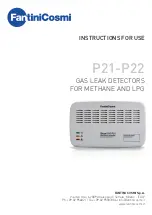
© 2021 All rights reserved. Data subject to change without notice.
21
Rev. E | 2021.03
LPT - Operation Manual
There are some installation procedures that will reduce the likelihood of getting faulty readings:
1.
Locate the detectors and controllers out of the way from normal foot traffi c and high
energy equipment.
2. Confi rm the devices are properly grounded using conduit and shielded cabling.
3. Inform oper
ators and technical staff working in the surrounding area to be aware of these
possible conditions and that two way radios, Bluetooth enabled devices, cell phones and
other electrical equipment may interfere with the response of the gas detectors.
6.5.3 Mounting Height (Sensor Dependent)
The sensor mounting height depends on the density of the gas relative to air. Heavier than air gases
should be detected 6 in / 15 cm from the fl oor, lighter than air gas sensors should be placed on or
near the ceiling, and gases which have a density close to that of air should have sensors installed
in the “breathing zone” 4 - 6 ft / 1.2 - 1.8 m from the fl oor. The breathing zone refers to the area
4 - 6 ft / 1.2 - 1.8 m from the fl oor, where most human breathing takes place. This is a good default
location for sensors, as many gases are often well dispersed in air.
GAS
APPLICATIONS / TYPES
SUGGESTED MOUNTING HEIGHT
Carbon Monoxide (CO)
Gas engine exhaust
4 - 6 ft above the fl oor
1.2 - 1.8 m above the fl oor
Nitrogen Dioxide (NO
2
)
Diesel engine exhaust
Ammonia (NH
3
)
Commercial ice rinks
Compressor rooms
Near or on the ceiling
Chlorine (Cl
2
)
Commercial swimming pools
6 in above the fl oor
15 cm above the fl oor
Oxygen (O
3
)
Hospitals, Laboratories
Chemical Storage Rooms
4 - 6 ft above the fl oor
1.2 - 1.8 m above the fl oor
















































